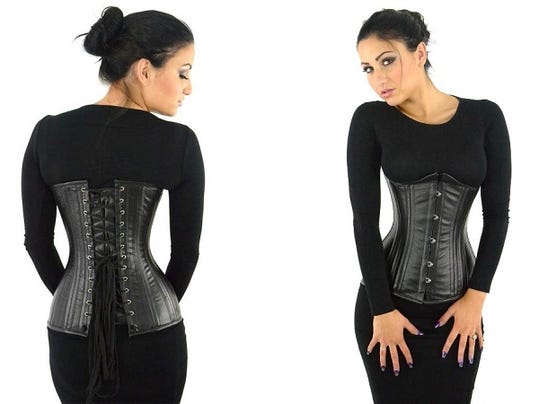Team Anti-Squeem – how the newest fitness fad is just dangerous

The squeem is the newest fitness fad that’s been seen on Instagram and other social media sites. A “squeem” is a modern day corset you can wear at the gym (or for 5-6 hours during the day) with the intention of “training your waist” to be smaller.
First of all, let’s examine how insane that sounds. Wearing a constricting device around your waist for a few hours will not change the genetics or shape of that area in a permanent sense. If anything, the minute the waist cincher is removed your waist will return to its normal size. Since it just provides an insane amount of pressure on the area there is no permanent change happening. It’s like saying wearing skinny jeans all day will shrink your legs – no.
(The only exception to the rule I will admit is Cathie Jung, who has been wearing a corset for 24 hours a day since 1959. In 1959 she had a 26″ waist, now it’s 15″. Plus, she is unable to drive a car or do many every day functions because she can’t move.)
Speaking of skinny jeans – have you ever worn a pair of skinny jeans a size or two too small? You remember how parts of your leg and hips would go numb, how you’d get pain and tingling sensations as the nerves were compressed and the blood flow restricted in those areas? Imagine doing that to your abdomen, where just under the skin and muscle lay important organs. Dr. Orly Avitzur, a neurologist, has written several articles about the dangers of Spanx, Squeems and other restrictive shapewear here.
These restrictive items make you sweat a lot, though. Removing water from any area of your body will help decrease the inches – just look at those scam body wraps that people sell. They don’t lose any -true- weight, it’s just the water leaving the tissues. The moment the area is rehydrated the inches return with the weight.
Additionally, these waist trainers apply pressure along the bottom of your rib cage which may disallow for full expansion of your lungs. When the lung cannot fully expand you run the risk of not fully oxygenating your blood. Additionally, a very severe side effect of a lung not being able to expand is collapse of the lung lobe itself. These are very severe complications that can occur, whether they’re common or not. The best question you should ask yourself is “Why should I wear something that restricts my ability to breathe while I work out?”
Now, I know we’ve all seen those images of women who’ve worn corsets back in the day. It’s important to note that these modern day squeems do not have the metals that those corsets do. Any conclusions we drew from the extreme restriction of those corsets won’t necessarily transfer over to modern day. In my research I found one modern day corset wearer who underwent an MRI to compare her organ location and size to the average person. They found shifting of organs (the liver and spleen shifted upwards, the large intestine shifted downwards) but no significant changes in the anatomy of the organs. They argue that a woman undergoes similar shifts during pregnancy with her organs, so how is it different?
My argument? 9 months of your organs moving slowly is quite different from wearing an artificial device that cinches down on your waist 24/7. Additionally, the slow growth of a fetus allows for organs to adapt to the changes. My question isn’t about how the organs look, but rather how they work. You cannot simply look at an MRI of an organ and determine that it’s working well and fine. Without blood work or biopsy there’s no way to assess if the constant pressure has lead to ischemia, pressure necrosis, re-perfusion injuries when the squeem is taken off, etc.
If you want to lose weight, you need to get into a caloric deficit. If your genetics tells you to hold onto weight in your abdomen, you’ll lose it there last. There’s no good way to “beat” genetics, especially not by wearing restrictive clothing in hopes it forces your body to remodel. It doesn’t work that way.
Want a smaller waist? Take a hint from the bodybuilding pros – create an illusion. Focus on building a larger upper and lower body that accentuate the X shape of your midsection. Dress in clothing that flatters your shape and either hides areas you’re self conscious about or simply draws attention away from it. Try to work WITH your body, not against it, and you won’t have to worry about the long term effects of compressing vitals organs.
